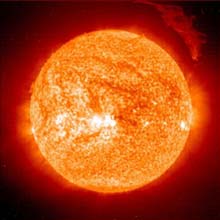SOHO snaps spectacular Sun shot

SOHO sees eruptive prominence <br>Credits: ESA/NASA
On Friday, 12 March 2004, the Sun ejected a spectacular ’eruptive prominence’ into the heliosphere. SOHO, the ESA/NASA solar watchdog observatory, faithfully recorded the event.
This ’eruptive prominence’ is a mass of relatively cool plasma, or ionised gas. We say ’relatively’ cool, because the plasma observed by the Extreme-ultraviolet Imaging Telescope (EIT) on board SOHO was only about 80 000 degrees Celsius, compared to the plasma at one or two million degrees Celsius surrounding it in the Sun’s tenuous outer atmosphere, or ’corona’.
At the time of this snapshot, the eruptive prominence seen at top right was over 700 000 kilometres across – over fifty times Earth’s diameter – and was moving at a speed of over 75 000 kilometres per hour.
Eruptive prominences of this size are associated with coronal mass ejections (CMEs), and the combination of CMEs and prominences can affect Earth’s magnetosphere when directed toward our planet. In this case, the eruptive prominence and associated CME were directed away from Earth.
SOHO is a mission of international co-operation between ESA and NASA, launched in December 1995. Every day SOHO sends thrilling images from which research scientists learn about the Sun’s nature and behaviour. Experts around the world use SOHO images and data to help them predict ’space weather’ events affecting our planet.
Media Contact
More Information:
http://www.esa.int/esaSC/SEMBYM8CURD_extreme_0.htmlAll latest news from the category: Physics and Astronomy
This area deals with the fundamental laws and building blocks of nature and how they interact, the properties and the behavior of matter, and research into space and time and their structures.
innovations-report provides in-depth reports and articles on subjects such as astrophysics, laser technologies, nuclear, quantum, particle and solid-state physics, nanotechnologies, planetary research and findings (Mars, Venus) and developments related to the Hubble Telescope.
Newest articles

First-of-its-kind study uses remote sensing to monitor plastic debris in rivers and lakes
Remote sensing creates a cost-effective solution to monitoring plastic pollution. A first-of-its-kind study from researchers at the University of Minnesota Twin Cities shows how remote sensing can help monitor and…

Laser-based artificial neuron mimics nerve cell functions at lightning speed
With a processing speed a billion times faster than nature, chip-based laser neuron could help advance AI tasks such as pattern recognition and sequence prediction. Researchers have developed a laser-based…

Optimising the processing of plastic waste
Just one look in the yellow bin reveals a colourful jumble of different types of plastic. However, the purer and more uniform plastic waste is, the easier it is to…


